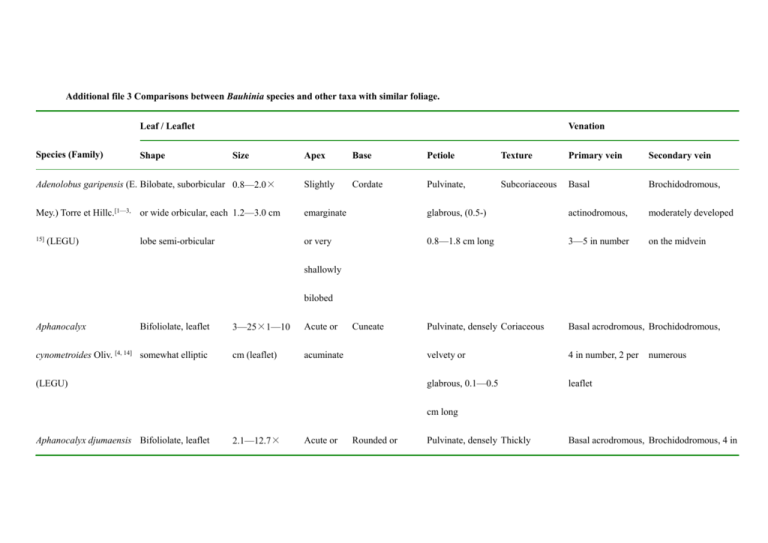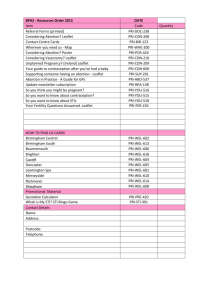file - BioMed Central
advertisement

Additional file 3 Comparisons between Bauhinia species and other taxa with similar foliage. Leaf / Leaflet Species (Family) Apex Base Petiole Texture Primary vein Secondary vein Adenolobus garipensis (E. Bilobate, suborbicular 0.8—2.0× Slightly Cordate Pulvinate, Subcoriaceous Basal Brochidodromous, Mey.) Torre et Hillc.[1—3, or wide orbicular, each 1.2—3.0 cm emarginate glabrous, (0.5-) actinodromous, moderately developed 15] or very 0.8—1.8 cm long 3—5 in number on the midvein Pulvinate, densely Coriaceous Basal acrodromous, Brochidodromous, velvety or 4 in number, 2 per glabrous, 0.1—0.5 leaflet (LEGU) Shape Venation Size lobe semi-orbicular shallowly bilobed Aphanocalyx Bifoliolate, leaflet cynometroides Oliv. [4, 14] somewhat elliptic 3—25×1—10 Acute or cm (leaflet) acuminate Cuneate (LEGU) numerous cm long Aphanocalyx djumaensis Bifoliolate, leaflet 2.1—12.7× Acute or Rounded or Pulvinate, densely Thickly Basal acrodromous, Brochidodromous, 4 in (De Wild.) J. Léonard [4, 14]semi-ovate to 0.9—4.7 cm (LEGU) (leaflet) semi-obovate acuminate cuneate velvety or coriaceous 4 in number, glabrous, 0.2—1 including 1 cm long inner-marginal per number per leaflet leaflet Aphanocalyx richardsiae Bifoliolate, ovate or 0.9—13× Acute or Rounded or Pulvinate, densely Thinly to thickly Basal acrodromous, Eucamptodromous to (J. Léonard) Wieringa ovate-elliptic, leaflet 0.5—4.5 cm (long) cuneate, rarely velvety or [= Monopetalanthus semi-ovate-elliptic or (leaflet) acuminate auriculate richardsiae J. Léonard] [3, semi-ovate-elliptic 4, 9, 14] coriaceous 4 in number, brochidodromous, glabrous, 0.1—0.7 including 1 4—6 in number per cm long inner-marginal per leaflet (LEGU) leaflet Aphanocalyx singidaensis Bifoliolate, leaflet At least 6 × Apparently Acute to obtuse Pulvinate, 2 cm Herend. et B.F. Jacobs[4] obliquely ovate, 1.9—2.8 cm acute long (fossil LEGU) somewhat falcate (leaflet) Bauhcis moranii Bilobate, wide ovate to 4.3—4.5× Bifid to Truncate or Unknown Pulvinate, at least Unknown Basal acrodromous, Eucamptodromous, ca. 2 in number, 1 per 10 in number, with leaflet 1—2 intersecondaries Basal Brochidodromous, Calvillo-Canadell et elliptic-oblate 5.8—6.4 cm 1/8—1/7 of cordate Cevallos-Ferriz[26] (fossil laminar LEGU) length Bauhinia acuminata L. [5, 6, Bilobate, ovate, 7—12×8—12.5 Bifid to 8, 17, 36] cm (LEGU) ovate-orbicular to suborbicular 0.5—1.2 cm long actinodromous, 7 in with 3—5 number intersecondary veins on the midvein Cordate Pulvinate, Subcoriaceous Basal Brochidodromous, usually rare 1/3—2/5 of pubescent, 2.5—4 actinodromous, laminar cm long 7—11 in number, length outmost veins weak, midvein apex spinose Bauhinia binnata Blanco Bifoliolate, leaflet wide 2.5—4.5× Rounded at Wide cuneate Pulvinate, slender, Chartaceous Basal [= Lysiphyllum binatum leaflet apex 1.0—2.5 cm long actinodromous, (Blanco) de Wit] [2, 3, 8] (LEGU) ovate 2.5—3.5 cm (leaflet) 8—10 in number Brochidodromous Bauhinia brachycarpa Bilobate, suborbicular 0.5—12×1—10 Bifid to ca. Truncate or Wall. ex Benth. [2, 5, 6, 17, 36] cm (LEGU) Pulvinate, 0.6—6 Chartaceous or 1/3—1/2 of shallowly cordate cm long membranous Basal Brochidodromous, actinodromous, none on the midvein laminar 5—13 in number, length; lobe outmost veins weak, apex midvein apex rounded spinose Bauhinia championii Bilobate or entire, ovate3—10×2.5—9 Acute, Truncate, cordate, Pulvinate, slender, Chartaceous to Basal Brochidodromous, (Benth.) Benth. or cordate obtuse or rounded or actinodromous, 3—4 in number, none 5—9 in number on the midvein cm [= Lasiobema championii emarginate, concave (Benth.) de Wit] [2, 3, 5, 6—8, or variously 17, 36] bilobed; (LEGU) lobe apex acute, 1.0—2.5 cm long coriaceous acuminate or obtuse Bauhinia cheniae Qi Wang Bilobate, wide ovate or 2.0—6.0× Bifid to ca. Moderately or Pulvinate, with et al. [36, this paper] (fossil 2/3—4/5 or deeply cordate suborbicular 2.2—6.5 cm LEGU) Apparently Basal Eucamptodromous, a spreading hairs or chartaceous actinodromous, pair on the midvein almost to no trichomes, 7—9 in number near the sinus the base; 1.6—2.0 cm long Basal Brochidodromous shortly acuminate, obtuse or rounded at lobe apex Bauhinia didyma L. Chen Bifoliolate, 1.2—2.4× Obtuse or [2, 5, 6, 17, 36] (LEGU) 0.9—1.6 cm rounded at suborbicular, leaflet Truncate Pulvinate, glabrous, 1—2.4 Membranous actinodromous, 6 in obliquely obovate (leaflet) leaflet apex cm long number, 3 per leaflet Bauhinia ecuadorensis Bifoliolate, 5.25×2.5 cm Rounded at Wide cuneate Pulvinate, stout, Apparently thin Basal E.W. Berry[27] (fossil suborbicular, leaflet (leaflet) leaflet apex ca. 1.5 cm long and stiff LEGU) obliquely ovate-elliptic Bauhinia fassoglensis Bilobate, wide ovate or 5—11.5 (-20)× Bifid to Schweinf. suborbicular Brochidodromous, actinodromous, 8 in numerous number, 4 per leaflet Deeply cordate 5.5—12 (-23) cm 1/10—1/3 Pulvinate, Chartaceous Basal Brochidodromous, rusty-pubescent or actinodromous, 8—10 in number, none on the midvein [= Tylosema fassoglensis (rarely 1/2); densely 9—11 in number, (Schweinf.) Torre et rounded at tomentous, midvein apex Hillc.] [2, 3, 9] (LEGU) lobe apex 1.5—22 cm long spinose Acuminate Rounded or Pulvinate, slender, Chartaceous Basal Eucamptodromous, 1 actinodromous, pair on the midvein Bauhinia humblotiana Simple, unlobed, ovate (7-) 11—21× Baill. to ovate-elliptic [= Gigasiphon humblotianum (Baill.) 7—14 cm shallowly cordate glabrous, 1.5—3.5 cm long 5—7 in number Drake] [3, 12] (LEGU) Bauhinia krishnanunnii Bilobate, wide ovate or 6×5 cm Emarginate, Cordate A.K. Mathur et al. [28] suborbicular U-shaped Not preserved Coriaceous Eucamptodromous actinodromous, 7 in (fossil LEGU) number Bauhinia larsenii D.X. Bilobate, suborbicular 2.1—4.5× Bifid to ca. Rounded or Zhang et Y.F. Chen[16, 36, or slightly ovate to 1/2—3/5; this paper] (fossil wide ovate LEGU) Basal 1.8—4.8 cm Pulvinate, ca. shallowly cordate 1—2.2 cm long Basal chartaceous actinodromous, rounded or 5—9 in number, obtuse at midvein apex lobe apex spinose Bauhinia marabarica Bilobate, wide ovate or 5—12×8—16 Bifid to Rounded to Pulvinate, Roxb. suborbicular 1/8—1/4; subcordate cm Apparently Basal Brochidodromous, grooved, densely actinodromous, 5—8 in number, none 7—11 in number on the midvein [= Piliostigma rounded at pubescent, 2—4 marabaricum (Roxb.) lobe apex cm long Coriaceous Brochidodromous Benth.] [2, 8] (LEGU) Bauhinia nepalensis N. Bilobate, each lobe 4.5—7.5× Emarginate; Auriculate Pulvinate, 3.8 cm Thickly Basal Awasthi et N. Prasad[29] ovate to elliptic 2.8—5.7 cm obtuse to long actinodromous, 11 about 4—6 pairs (fossil LEGU) chartaceous rounded at Eucamptodromous, in number lobe apex Bauhinia ningmingensis Bifoliolate, each leaflet 4.0—5.3× Qi Wang et al. [36, this paper] obliquely ovate or (fossil LEGU) 2.0—2.6 cm Acutely Wide cuneate or Pulvinate, petiole Apparently obtuse slightly concave not preserved slightly falcate Bauhinia purpurea L. [2, 3, Bilobate, suborbicular 10—15× 9—14 Bifid to 5—8, 17, 23, 36] (LEGU) cm 1/3—1/2; Shallowly cordate Pulvinate, 3—4 cm long Basal acrodromous, Brochidodromous membranous to 3—4 in number per chartaceous leaflet Stiffly Basal Eucamptodromous, chartaceous actinodromous, none on the midvein slightly 9—13 in number, acute or midvein and rarely outmost veins weak rounded at lobe apex Bauhinia ramthiensis Bilobate, each lobe Antal et N. Awasthi[30] elliptic Ca. 9.0×4.3 cm Not Cordate Not preserved Coriaceous preserved number Bauhinia siwalika U. Bifoliolate, leaflet more 1.5—4.0×1—3 Rounded Lakh. et N. Awasthi[31] or less ovate Auriculate cm Pulvinate, thick, Chartaceous 0.8—1.0 cm long Basal Brochidodromous actinodromous, (fossil LEGU) 3—4 in per leaflet Bauhinia sp. 1[32 ](fossil Bilobate, wide ovate or At least 3×7 cm Bifid to 1/4; Cordate Pulvinate, thick, LEGU) orbicular 3.5 cm long lobe apex Coriaceous Bilobate, lobe ovate 5.5×7.0 cm Incompletely preserved number Bifid to ca. Approximately 2/5; Basal actinodromous, 9 in missing (Cf. Bauhinia purpurea Eucamptodromous, actinodromous, 9 in numerous (fossil LEGU) Bauhinia sp. 2 Basal rounded Not preserved Coriaceous Basal actinodromous, 9 in Brochidodromous L.) [33] (fossil LEGU) rounded at number lobe apex Bauhinia thonningii Bilobate, wide ovate Schumach. 5—17×6—19 Bifid to cm 1/8—1/3; Cordate Pulvinate, thick, Coriaceous 1.0—4.2 cm long Basal Eucamptodromous or actinodromous, brochidodromous, [= Piliostigma thonningii rounded at 7—11 in number, numerous, 1—2 on the (Schumach.) Milne-Redh.] lobe apex midvein apex midvein [3, 9, 15] (LEGU) spinose Bauhinia variegata L. [= Bilobate, suborbicular 5—10×7—14 Bifid to Truncate or Pulvinate, 2.5—4 (Sub)coriaceous Basal Eucamptodromous, Phanera variegata (L.) 1/3—1/2; shallowly to cm long none on the midvein or wide ovate cm actinodromous, Benth.] [2, 3, 5—8, 17, 36] rounded at deeply cordate 9—11, rarely 13 in (LEGU) lobe apex number, midvein apex spinose Bauhinia waylandii R.W. Bilobate, suborbicular, 2.5×2.5 cm Bifid to 1/3; Broadly cordate Pulvinate, stout, at Stiff Basal Brochidodromous, Chaney[34] (fossil LEGU) lobe ovate rounded at least 1.3 cm long actinodromous, 7 in slender lobe apex Brenierea insignis Bifoliolate, leaflet 0.6—1.2× Humbert [2, 3, 12] (LEGU) oblong or obovate to suborbicular number Rounded at Cuneate Grooved above, Somewhat Basal acrodromous, Brochidodromous, 0.35—0.9 (-1.2) leaflet apex puberulous, thickened 3 or 4 in number per none on the midvein cm (leaflet) densely scaly, leaflet 0.2—0.6 cm long Cercis canadensis L. [2, 17, Simple, unlobed, 4—10 ×4—10 Acuminate Shallowly cordate Pulvinate, 22, 23, 36] suborbicular or wide cm or slightly ovate wider than long (LEGU) 1.5—5.0 cm long Cercis chinensis Bunge [2, Simple, unlobed, 5—10 ×5—10 Acute Shallowly to Pulvinate, 1—4 5, 6, 17, 24, 36] suborbicular or cm or slightly deeply cordate cm long triangular-orbicular longer than wide (LEGU) Cercis miochinensis H.H. Simple, unlobed, 3.3—13× Chartaceous Acuminate Wide cordate Pulvinate, up to Chartaceous Chartaceous Basal Brochidodromous, actinodromous, 2—4 pairs on the 5—7 in number midvein Basal Brochidodromous, actinodromous, 2—3 pairs on the 5—7 in number midvein Basal Brochidodromous, Hu et R.W. Chaney [24, 36] suborbiculate or wide 2.7—11 cm (fossil LEGU) 2.9 cm long ovate 2—4 pairs on the 5—7 in number midvein Basal Brochidodromous, 4 in actinodromous, number per leaflet Colophospermum mopane Bifoliolate, 4.5—10× Obtuse or Rounded or wide Pulvinate, (Kirk ex Benth.) Kirk ex J. butterfly-like, leaflet 1.5—5.0 cm obtusely cuneate Léonard [3, 4, 10, 15] (LEGU) sub-triangular or (leaflet) acuminate numerous, 8—11 in at leaflet number per leaflet obliquely ovate Coriaceous actinodromous, 1.8—2.5 cm long apex Cynometra bauhinaefolia Bifoliolate, leaflet Benth. [4, 13] (LEGU) 1—4×0.5—2.0 Acuminate, Cuneate Pulvinate, Thinly 2 in number, 1 per Pinnate, coriaceous leaflet brochidodromous, ca. obliquely ovate-oblong cm (leaflet) with a glabrous to to ovate-lanceolate retuse tip densely pilose, 5—8 pairs per leaflet 0.2—0.6 cm long Cynometra elmeri Merr. Bifoliolate, leaflet (ob) 3.5—15× Acuminate, Cuneate Pulvinate, [11, 36] ovate-oblong or oblong,1.3—4.0 cm with a 0.4—0.8 cm long (LEGU) Coriaceous 2 in number, 1 per Pinnate, leaflet brochidodromous, ca. somewhate falcate (leaflet) retuse tip 5—7 pairs per leaflet Griffonia physocarpa Simple, alternate, 5—15×3—7 cm Acuminate Rounded Baill. [2, 3, 25] (LEGU) unlobed, oblong-elliptic Pulvinate, ca. Coriaceous 1 midvein 0.5—1.0 cm long Pinnate, brochidodromous, to ovate 4—5 pairs, including a strong, basal pair Guibourtia coleosperma Bifoliolate, 7.0—10× Obtusely Obtuse or slightly Pulvinate, (Benth.) J. Léonard [4, 15] butterfly-like, leaflet 3.8—4.8 cm acuminate cuneate (LEGU) obliquely ovate (leaflet) Coriaceous 1.9—2.8 cm long 2 in number, 1 per Pinnate, leaflet brochidodromous, ca. 5—7 pairs per leaflet, with 2—3 intersecondaries Hardwickia binata Roxb. Bifoliolate, 2—6×0.7—3.3 Obtusely [3, 4, 10, 11, 17, 36] cm (leaflet) (LEGU) butterfly-like, leaflet obliquely ovate or acute Obtuse Pulvinate, slender, Coriaceous Basal acrodromous, Eucamptodromous, ca. glabrous, 1.2—2.5 4—6 per leaflet cm long 4—5 in number per leaflet semi-orbicular Hymenaea verrucosa Bifoliolate, leaflet 5—9×2.5—4 cm Shortly Gaertn. [3, 5, 6, 12, 17, 36] obliquely elliptic, (leaflet) (LEGU) curved Obtuse, decurrent Glabrous, 1.2—2.0 Coriaceous 2 in number, 1 per Pinnate, leaflet brochidodromous, ca. acuminate cm long; petiolule to obtuse twisted, 0.1—0.3 5—7 pairs per leaflet, cm long with 2—3 intersecondaries Dilobeia thousarsii Roem. Bilobate, obovate et Schult.[35] (PROT) Ca. 12.5×11.3 cm Bifid to 3/10; Concave, decurrentNormal, ca. 7 cm Coriaceous long Suprabasal Pinnate, actinodromous, brochidodromous, rounded at usually 3 in number, including a pair on the lobe apex including 1 midvein, midvein near the sinus reaching the sinus of the apical notch Hoya kerrii Craib Bilobate, obovate to 4—6×5—6 cm Retuse, Rounded or wide Robust, 0.5—2.0 Succulent, thick 1 midvein Pinnate, obscure [= Hoya obovata Decaisne orbicular shallowly var. kerrii (Craib) emarginate cuneate cm long Wide cuneate, Robust, 2—14 cm Succulent, rather 1 midvein, Costantin.] [17, 36] (APOC) Ipomoea pes-caprae (L.) Bilobate, ovate, elliptic, 3.5—9 × 3—10 Bifid to R. Br. [17, 36] (CONV) 1/5—1/4 or truncate, or circular, reniform or cm long Pinnate, thick, sometimes spinose brochidodromous, at the apex somewhat quadrate to emarginate; shallowly cordate 2-glandular oblong rounded at abaxially 5—7 pairs, with 2—3 intersecondaries lobe apex Liriodendron tulipifera L. Commonly with 2 (4-) 7.5—15 Broad Truncate to Normal, 4—11.5 Membranous to 1 midvein Pinnate, [17, 21, 36] (LIRD) shallow upper lobes (-23.5) × (8.5-) truncate, slightly cordate, (-16) cm long brochidodromous or and 2 lateral lobes at 12.5—18.5 emarginate sometimes with 1 craspedodromous 5—7 broadest part, or (-25.5) cm or 2-lobed; lateral lobe near pairs sometimes squarrose acute or base of each side chartaceous and barely lobed acuminate at lobe apex Liriodendrites bradacii Bilobate, somewhat 4—13 × 5—11 Bifid to ca. Truncate to Normal, ca. 2—7 Unknown 1 midvein, reaching Pinnate, K.R. Johnson [18, 19, 21] quadrate cm 1/2—4/5; cm long the sinus of the brochidodromous, apical notch 2—6 pairs (fossil LIRD) rounded, rarely rounded or acute or cordate emarginate, rarely bilobate at lobe apex Liriodendrites Bilobate, orbicular or 7—9 × 8—9 cm Bifid to Cordate Not preserved Unknown 1 midvein, reaching Pinnate, sachalinensis (Krysht.) P.I. ovate 1/4—1/3; the sinus of the brochidodromous, Alekseev [19, 21] (fossil rounded or apical notch 5—6 pairs LIRD) obtuse at lobe apex Liriophyllum kansense Bilobate, quadrate to 6—14 × Bifid to ca. Shallowly cordate, Stout, up to 10 cm Unknown 1 midvein, Pinnate, Dilcher et P.R. Crane wide ovate 6.4—18.6 cm 1/2—3/5; acute or obtuse, long, simple, dichotomizing brochidodromous, broadly straight or more without alate slightly before the 2—5 pairs appendages leaf margin [19—21] (fossil LIRD) rounded at typically lobe apex Oxalis corymbosa DC. [17, Trifoliolate, leaflet 1.0—4.5 × 1.5—6 Deeply 36] cm (OXAL) obcordate decurrent Wide cuneate emarginate (leaflet) Passiflora cupiformis Bilobate, obovate or 6—12 (-15) × 4 Bifid to Rounded to Masters [17, 36] (PASS) somewhat quadrate to —10 cm 1/5—1/4 or cordate, truncate oblong 5—30 cm long, Membranous 1 midvein Pinnate, with sparse or brochidodromous, dense trichomes 2—3 pairs 3—7 cm long, Coriaceous Basal Brochidodromous, sparsely actinodromous, numerous, with a pair truncate; pubescent, with 2 usually 3 in number, on the midvein rounded or discoid glands rarely 5, midvein obtuse at apex spinose lobe apex Zygophyllum fabago L. [17, Bifoliolate, leaflet 1.5—3.3 × Rounded or Cuneate 1—3 cm long, 36] obovate to 0.6—2.0 cm obtuse grooved, with oblong-obovate (leaflet) (ZYGO) Succulent, thick 2 in number, 1 per leaflet linear wings Pinnate, brochidodromous, ca. 2—4 in number References 1. Brummitt RK, Ross JH: A reconsideration of the genus Adenolobus (Leguminosae–Caesalpinioideae). Kew Bull 1976, 31:399–406. 2. Zhang DX: Leaf venation of Cercideae (Leguminosae). J Trop Subtrop Bot 1994, 2:45–57. 3. Lewis G, Forest F: Tribe Cercideae. In Legumes of the world. Edited by Lewis G, Schrire B, Mackinder B, Lock M. Kew: The Royal Botanic Gardens; 2005:57–68. 4. Herendeen PS, Jacobs BF: Fossil legumes from the middle Eocene (46.0 Ma) Mahenge flora of Singida, Tanzania. Amer J Bot 2000, 87:1358–1366. 5. Chen TC: Bauhinia Linn. In Flora Reipublicae Popularis Sinicae, Tomus 39. Edited by Wu TL, Chen PY, Wei CF, Chen TC. Beijing: Science Press; 1988:145–203. 6. Chen TC, Zhang DX, Larsen K, Larsen SS: Bauhinia Linnaeus. In Flora of China, vol. 10. Edited by Wu ZY, Raven PH, Hong DY. Beijing: Science Press & St. Louis: Missouri Botanical Garden Press; 2010:6–21. 7. Yu CH, Chen ZL: Leaf architecture of the woody dicotyledons from tropical and subtropical China. Beijing: Pergamon Press; 1991:1–414. 8. De Wit HCD: A revision of Malaysian Bauhinieae. Reinwardtia 1956, 3:381–539. 9. Brenan JPM: Leguminosae subfamily Caesalpinioideae. In Flora of Tropical East Africa. Edited by Milne-Redhead E, Polhill RM. London: Crown Agents for Oversea Governments and Administrations; 1967:1–230. 10. Welman M: Colophospermum mopane is the correct name for the "mopane". SABONET News 1999, 4:188–195. 11. Knaap van Meeuwen MS: The Indo-Malesian and Pacific Cynometreae. Blumea 1970, 18:13–53. 12. Du Puy DJ, Labat JN, Rabevohitra R, Villiers JF, Bosser J, Moat J: The Leguminosae of Madagascar. Kew: The Royal Botanic Gardens; 2002:1–737. 13. Dwyer JD: The new world species of Cynometra. Ann Missours Bot Gard 1958, 55:311–345. 14. Wieringa JJ: Monopetalanthus exit. A systematic study of Aphanocalyx, Bikinia, Icuria, Michelsonia and Tetraberlinia (Leguminosae, Caesalpinioideae). Wageningen Agric Univ Pap 1999, 99 (4):1–320. 15. Palmer E, Pitman N: Trees of southern Africa, vol. 2. Cape Town A. A. Balkema; 1972:705–1497. 16. Chen YF, Zhang DX: Bauhinia larsenii, a fossil legume from Guangxi, China. Bot J Linn Soc 2005, 147:437–440. 17. eFloras.org. Published on the Internet [http://www.efloras.org/] (accessed 15 April 2014). St. Louis: Missouri Botanical Garden & Cambridge: Harvard University Herbaria. 18. Johnson KR: Description of seven common fossil leaf species from the Hell Creek Formation (Upper Cretaceous: Upper Maastrichtian), North Dakota, South Dakota, and Montana. Proc Denver Mus Nat Hist, Ser 3, 1996, 12:1–47. 19. Alekseev PI: Genus Liriodendrites in Cretaceous and Early Paleogene floras of northern Asia. Paleontol J 2009, 43:1181–1189. 20. Dilcher DL, Crane PR: Archaeanthus: An early angiosperm from the Cenomanian of the western Interior of North America. Ann Missouri Bot Gard 1984, 71:351–384. 21. Romanov MS, Dilcher DL: Fruit structure in Magnoliaceae s. l. and Archaeanthus and their relationships. Amer J Bot 2013, 100:1494–1508. 22. Owens SA, Fields PF, Ewers FW: Degradation of the upper pulvinus in modern and fossil leaves of Cercis (Fabaceae). Amer J Bot 1998, 85:273–284. 23. Owens SA: Secondary and tertiary pulvini in the unifoliate leaf of Cercis canadensis L. (Fabaceae) with comparison to Bauhinia purpurea L. Int J Pl Sci 2000, 161:583–597. 24. Wang Q: Pulvini of Cercis leaves from the Miocene Shanwang Formation of Shandong Province and the early evolution of the pulvinus in Leguminosae. Acta Palaeontol Sin 2012, 51:1–13. 25. Aubréville A: Légumineuses-Caesalpinioidées. In Flore du Gabon, vol. 15. Aubréville A, Leroy JF. Paris: Muséum Nationale d’Histoire Naturelle; 1968:1–362. 26. Calvillo-Canadell L, Cevallos-Ferriz SRS: Bauhcis moranii gen. et sp. nov. (Cercideae, Caesalpinioideae), an Oligocene plant from Tepexi de Rodríguez, Puebla, Mexico, with leaf architecture similar to Bauhinia and Cercis. Rev Palaeobot Palynol 2002, 122:171–184. 27. Berry EW: Fossil floras from southern Ecuador. Johns Hopkins Univ Stud Geol 1945, 14:93–150. 28. Mathur AK, Mishra VP, Mehra S: Systematic study of plant fossils from Dagshai, Kasauli and Dharmsala formations of Himachal Pradesh. Geol Surv India, Palaeontol Indica, N S 1996, 50:1–121. 29. Awasthi N, Prasad M: Siwalik plant fossils from Surai Khola area, western Nepal. Palaeobotanist 1990, 38:298–318. 30. Antal JS, Awasthi N: Fossil flora from the Himalayan foot-hills of Darjeeling District, West Bengal, India and its palaeoecological and phytogeographical significance. Palaeobotanist 1993, 42:14–60. 31. Lakhanpal RN, Awasthi N: A late Tertiary forule from near Bhikhnathoree in West Champaran District, Bihar. In Proceedings of the symposium on evolutionary botany and biostratigraphy. Current Trends in Life Sciences 10 (A. K. Ghosh Commemoration Volume). Edited by Sharma AK, Mitra GC, Banerjee M. New Delhi: Today and Tomorrow’s Printers & Publishers; 1984: 587–596. 32. Endo S, Fujiyama I: Some Late Mesozoic and Late Tertiary plants and a fossil insect from Thailand. In Contributions to the geology and palaeontology of Southeast Asia 31, geology and palaeontology of Southeast Asia, volume 2. Edited by Kobayashi T, Toriyama R. Tokyo: University of Tokyo Press; 1966:191–197. 33. Bande MB, Srivastava GP: Late Cenozoic plant-impressions from Mahuadnar Valley, Palamu District, Bihar. Palaeobotanist 1990, 37:331–366. 34. Chaney RW: A Tertiary flora from Uganda. J Geol 1933, 41:702–709. 35. Pole M, Bowman DMJS: Tertiary plant fossils from Australia’s ‘Top End’. Austral Syst Bot 1996, 9:113–126. 36. Direct observations on the cultivated plants and the specimens deposited at Chengdu Institute of Biology, Chinese Academy of Sciences (CDBI), Guangxi Institute of Botany, Chinese Academy of Sciences (IBK), South China Botanical Garden, Chinese Academy of Sciences (IBSC), the Herbarium of Northeast China (IFP), Kunming Institute of Botany, Chinese Academy of Sciences (KUN), Natural History Museum of Guangxi (NHMG), and the Chinese National Herbarium (PE) (see Additional file 2).





